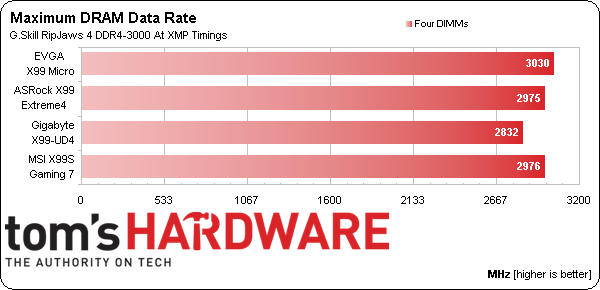EVGA X99 Micro Motherboard Review: Haswell-E And MicroATX
Power, Heat, Efficiency And Overclocking
Power, Heat And Efficiency
EVGA’s X99 Micro fits mid-pack in energy consumption, which means that it should also appear mid-pack in efficiency. That quick-and-dirty analysis comes from its average-looking performance in the majority of benchmarks.
The X99 Micro did suffer slightly higher CPU temperatures, but differences this small can be caused by paste placement as much as by voltage differences. Power consumption was consistent with the other products, after all.
I guessed at the top of the page that the EVGA X99 Micro’s mid-pack performance and power consumption would place it dead center in efficiency. The actual results are close, but the X99 Extreme4’s extra-low power consumption bent the curve.
Overclocking
| EVGA X99 Micro BIOS Frequency and Voltage settings (for overclocking) | |||
|---|---|---|---|
| BIOS Version | 5.6.5 (09/19/2014) | PCH Voltage | 0.90-1.60V (1mV) |
| Base Clock | 80-250MHz (0.05MHz) | DRAM Voltage | 0.80-2.00V (1mV) |
| CPU Multiplier | 12-80x (1x) | CAS Latency | 5-31 Cycles |
| DRAM Data Rates | 1200-2666 (200/266.6MHz) | tRCD | 5-31 Cycles |
| CPU Vcore | 0.80-2.00V (5mV) | tRP | 5-31 Cycles |
| VCCIN | 1.50-3.05V (1mV) | tRAS | 10-63 Cycles |
Every X99 motherboard we’ve tested is able to push this Core i7-5960X to a 44 x 101MHz core clock, where the additional voltage needed to achieve even higher core frequencies eventually causes thermal throttling. There’s nothing lost or gained in the X99 Micro in this respect.
The X99 Micro ties for last place in BCLK overclocking, though it will allow that same 2% increase to be applied to the 1.25x CPU strap for a 128MHz setting. That will be important when we begin to search for the ultimate in memory bandwidth.
To get that high memory bandwidth, we first need to find a high data rate. EVGA’s X99 Micro helps us by outputting near-perfect DIMM voltage, where both the CPU and DRAM need near-perfection to reach the RAM's rated DDR4-3000.
Memory settings that we don’t often notice, such as slower tertiary memory timings, often allow better overclocks at the cost of bandwidth. EVGA takes the top DRAM data rate, while ASRock and MSI compete for bandwidth superiority.
Get Tom's Hardware's best news and in-depth reviews, straight to your inbox.
Current page: Power, Heat, Efficiency And Overclocking
Prev Page Benchmark Results Next Page Big Value, Small Package?-
Crashman Replythe price is insane
It's X99, I don't think they could have shaved it by more than 20% even if it were produced by the tens of thousands in China. The question is, what do you think would be "sane"?
-
ohim Reply14433708 said:the price is insane
It's X99, I don't think they could have shaved it by more than 20% even if it were produced by the tens of thousands in China. The question is, what do you think would be "sane"?
Sorry .. for i don`t know what reason i saw a 485$ price tag initially ...that was an insane price. -
Xivilain EVGA makes good motherboards. I love my X79 I purchased. But X99 for $485 is truly insane for any motherboard manufacturer. They're riding the Intel inflation wave.Reply
Also, Amazon is selling this board for $250 USD. (http://www.amazon.com/EVGA-Socket-2666Mhz-Motherboard-131-HE-E995-KR/dp/B00MY3SKEY) Lucky us. -
Lutfij http://www.evga.com/Products/Product.aspx?pn=131-HE-E995-KR - $250Reply
http://www.newegg.com/Product/Product.aspx?Item=N82E16813188161&cm_re=X99_micro-_-13-188-161-_-Product $250
List pricing is, on most occasions, marked up. As demand come into factor the prices drop gradually. Most often the consumers reaction causes manufacturers to convey a price drop in the hopes of retaining their client base/loyalty.
Nevertheless, prices are within sanity now :) -
SU11YBEAR Got this board last month for a LAN build and am loving it so far (paired with an Evga 980 SC and 5930k, dual 240 rad and CPU/GPU waterblocks) board offers all the features I was looking for except the option for M2 storage which was slightly annoying but bearable, I consider the 4 slots of RAM a bonus, only going to use 4 anyways and frees up space for the smaller factor,Reply
Only real complaints I have with the board are 1) the IO backplate it came with was a plain silver and just looked cheap (painted it matte black to match the build) and 2) 2 of the fan headers are only settable via the bios and do not change (have used speedfan and bios for the PWM headers) so had to do some quick mods to make the rad fans run off two headers but not a huge deal,
The IO shield is a cool little option unfortunately since I was doing liquid in a tight case (Corsair 350D) had to remove it to make the tubes reach the top rad, haven't OC it fully yet (just got 4GHz on the chip for now) but looking forward to opening it up :) -
InvalidError Reply
Just about everything about LGA2011(-3) comes with insane prices anyway when compared against mainstream sockets. At least some 4x4GB DDR4 kits have already gone down by about $100 since Haswell-E's introduction.14435806 said:no way to get an x99 product with this ddr4 insane price.







